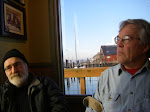Wednesday, March 31, 2010
Picking Avocados
Time flies like an arrow; fruit flies like a banana -- I heard this from Peggy Kass in Marin County
I picked avocados in Downey, California. It was Sunday morning, I was invited by Q to visit his home in Downey. He had told me many times about his wonderful avocado tree. And he had brought guacamole to the backyard BBQ on Saturday.
Everybody raved that it was the world's best guacamole, but Q said that's easy -- you just make it with very good avocados.
Like the kind that grows on his tree in Downey, which is southeast of downtown Los Angeles, and just east of the San Gabriel River.
You have to get used to these local rivers, which run in a trickle between concrete banks. They are real rivers that drain real watersheds -- you can't get too snobby about this if you come from a wetter climate.
We crossed the San Gabriel River. We could have waded, but we drove across on the 105 freeway, which is much easier.
Downey is a big town, over 100,000 people -- this is somewhere, but it's just not trendy. Downey is square, I think that's fair. People live in Downey because they like it here. The streets are quiet and spacious. You hear birds singing. And you can grow avocados and oranges in your backyard.
It gets hot in the summer, well into the nineties, because it's away from the ocean. And the smog settles in too, so that you can't see the San Gabriel Mountains to the north.
The heat has always been there, but you can get comfortable with it if you are intelligent. Q's house is stucco, which stays cool, and he has super-insulated windows, with drapes and shades. So he says, "We don't use AC, we just keep the windows closed until mid-afternoon, and it stays cool inside."
The air is still in the morning, but the onshore breeze begins most afternoons for a little cooling.
And there's the avocado tree, planted by intelligent people on the southside of Q's house, to give fruit and shade.
It's a big tree, we picked over one hundred, using a basket pole. This was the end of the season. The tree is harvested from September to March -- six months of abundance.
In April the fruit is gone, but flowers bloom and new small fruit grows through the summer, and the harvest begins again in the next September.
Persea americana is the scientific name for avocado. The fruit is picked rock hard. It does not ripen on the tree. Q said to let them drop to the ground and they won't bruise. He showed me some scalded spots, some brown rough spots, from fruit grown on the south side of the tree -- "The skin is burned by the sun on the south side of the tree but the insides are good."
I stay on the Westside when I am in Los Angeles --- super trendy, super expensive and near the beach. Everybody is rushing around hoping they won't miss out on the latest thing. It's kind of cool on the Westside. I mean, look at me -- I'm cool. That's why I'm on the Westside.
But Downey is beyond all trends, it is "trendscendental," a kind of higher realm. I didn't pick up a conservative right-wing vibe either. The right wing tends to be further south, down in Orange County. No, Downey is just kind of square, that's why I liked it there.
California grows more than 60,000 acres of avocados, and most of those acres are in San Diego County. The most abundant variety is the Hass. "All Hass avocado trees are descended from a single 'mother tree' that was raised by a mail carrier named Rudolph Hass, in La Habra Heights, California," according to Wikipedia.
Q's tree is the Fuerte variety. "Fuerte is a Mexican Guatemalan cross originating in the Mexican state of Puebla. The Fuerte earned its name, which means strong in Spanish, after it withstood a severe frost in California in 1913. Hardy to 26°F. Medium-sized pear-shaped fruit with a green leathery skin, easy to peel. Creamy flesh of mild and rich flavour. Oil 18%. The skin ripens green."
Friendly Korean Grocery Store Owners. Many Korean immigrants own small grocery stores on the West Coast, working long hours with grim faces. But they are learning how to be friendly, learning how to smile and greet their customers -- because that's a good thing, because that's the way we do it in America, and because it's good for business.
You may not have noticed this change, but I have been in friendly contact with Korean store owners for some years now. I have patiently worked with them, teaching them how to smile and say hello. This effort has begun to pay off. So, I ask you to join in this movement -- the next time you encounter a Korean store owner, give him a warm smile and a friendly hello -- his response might be very tentative, but you have to start somewhere.
--
Fred Owens
cell: 360-739-0214
send mail to:
Fred Owens
Box 1292
LaConner WA 98257
Subscribe to:
Post Comments (Atom)

No comments:
Post a Comment